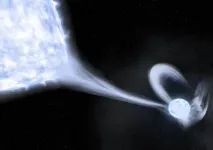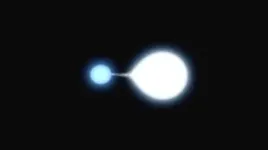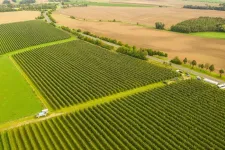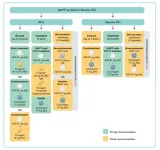(Press-News.org) Supernovae–stellar explosions as bright as an entire galaxy–have fascinated us since time immemorial. Yet, there are more hydrogen-poor supernovae than astrophysicists can explain. Now, a new Assistant Professor at the Institute of Science and Technology Austria (ISTA) has played a pivotal role in identifying the missing precursor star population. The results, now published in Science, go back to a conversation the involved professors had many years ago as junior scientists.
Some stars do not simply die down, but explode in a stellar blast that could outshine entire galaxies. These cosmic phenomena, called supernovae, spread light, elements, energy, and radiation in space and send galactic shock waves that could compress gas clouds and generate new stars. In other words, supernovae shape our universe. Among these, hydrogen-poor supernovae from exploding massive stars have long puzzled astrophysicists. The reason: scientists have not been able to put their finger on their precursor stars. It is almost as if these supernovae appeared out of nowhere.
“There are many more hydrogen-poor supernovae than our current models can explain. Either we can't detect the stars that mature on this path, or we must revise all our models,” says ISTA Assistant Professor Ylva Götberg. She pioneered this work together with Maria Drout, an Associated Faculty Member of the Dunlap Institute for Astronomy & Astrophysics, University of Toronto, Canada. “Single stars would typically explode as hydrogen-rich supernovae. Being hydrogen-poor indicates that the precursor star must have lost its thick hydrogen-rich envelope. This happens naturally in a third of all massive stars through envelope stripping by a binary companion star,” says Götberg. Now, Götberg and Drout combined their areas of expertise in theoretical modeling and observation to hunt down the missing stars. Their quest is successful: they document a first-of-its-kind star population that finally bridges a large knowledge gap and sheds light on the origin of hydrogen-poor supernovae.
Binary stars and envelope stripping
The stars that Götberg and Drout search for go in pairs: interlocked in a binary star system. Some binary systems are well-known to us Earthlings: these include the brightest star in our night sky, Sirius A, and its faint companion star Sirius B. The Sirius binary system is located only 8.6 light-years away from Earth–a stone’s throw in cosmic terms. This explains Sirius A’s observed brightness in our night sky.
Astrophysicists expect the missing stars to be initially formed from massive binary systems. In a binary system, the stars would orbit around one another until the more massive star’s thick, hydrogen-rich envelope expands. Eventually, the expanding envelope experiences a stronger gravitational pull to the companion star than to its own core. This causes a transfer of mass to begin, which eventually leads the entire hydrogen-rich envelope to be stripped off, leaving the hot and compact helium core exposed–more than 10 times hotter than the Sun’s surface. This is precisely the type of stars that Götberg and Drout are looking for. “Intermediate mass helium stars stripped through binary interaction are predicted to play important roles in astrophysics. Yet, they were not observed until now,” says Götberg. In fact, there is an important mass gap between the known classes of helium stars: the more massive Wolf-Rayet (WR) stars have more than 10 times the Sun’s mass, and the low-mass subdwarf stars could have around half the Sun’s mass. However, models have predicted the precursors of hydrogen-poor supernovae to lie between 2 and 8 solar masses following stripping.
Not just a needle in the haystack
Before Götberg and Drout’s study, only one star was found to fulfill the expected mass and composition criteria and was called “Quasi-WR” (or “Almost Wolf-Rayet”). “Yet, the stars that follow this path have such a long lifetime that many must be scattered all over the observable universe,” says Götberg. Did the scientists simply not “see” them? Thus, Götberg and Drout drew on their complementary expertise. With the help of UV photometry and optical spectroscopy, they identified a population of 25 stars that are consistent with the expectations for intermediate-mass helium stars. The stars are located in two well-studied neighboring galaxies, the Large and the Small Magellanic Clouds. “We showed that these stars were bluer than the stellar birthline, the bluest phase in a single star’s lifetime. Single stars mature by evolving towards the redder region of the spectrum. A star only shifts in the opposite direction if its outer layers are removed–something that is expected to be common in interacting binary stars and rare among single massive stars,” explains Götberg.
The scientists then verified their candidate star population using optical spectroscopy: they showed that the stars had strong spectral signatures of ionized helium. “Strong ionized helium lines tell us two important things: first, they confirm that the stars’ outermost layers are dominated by helium and, second, that their surface is very hot. This is what happens to stars left as an exposed, compact, helium-rich core following stripping,” says Götberg. Yet, both stars in a binary system contribute to the observed spectra. Thus, this technique allowed the researchers to classify their candidate population depending on which star contributed the most to the spectrum. “This work allowed us to find the missing population of intermediate-mass, stripped helium stars, the predicted progenitors of hydrogen-poor supernovae. These stars have always been there and there are probably many more out there. We must simply come up with ways to find them,” says Götberg. “Our work may be one of the first attempts, but there should be other ways possible.”
From graduate students at a conference to group leaders
The idea behind this project sparked in a discussion following a talk by Götberg at a conference that she and Drout attended during their graduate studies. Both scientists, then Early Career Researchers reaching for the stars, are now group leaders in their field. Götberg joined ISTA in September following her research at the Carnegie Observatories in Pasadena, California, as a NASA Hubble postdoctoral fellow. At ISTA, Götberg joins the Institute’s growing ranks of young group leaders in astrophysics and leads her own group focused on studying the binary interactions of stars.
This work, led by Maria R. Drout (Dunlap Institute for Astronomy & Astrophysics, University of Toronto, Canada) and Ylva Götberg (Institute of Science and Technology Austria, ISTA), was done in collaboration with The Observatories of the Carnegie Institution for Science (Pasadena, USA), and the Max Planck Institute for Astrophysics (Garching, Germany), among others.
END
Reaching for the (invisible) stars
Uncovering the missing precursors of hydrogen-poor supernovae
2023-12-14
ELSE PRESS RELEASES FROM THIS DATE:
How can Europe restore its nature?
2023-12-14
The ‘Nature Restoration Law’ (NRL) requires member states of the EU to implement restoration measures on at least 20 per cent of land and marine areas by 2030, and in all ecosystems in need of restoration by 2050. This includes specific targets to rewet peatlands and to increase pollinator populations. The NRL has already overcome various hurdles: most recently, it was approved by the EU Parliament’s Environment Committee, after delegations of the Parliament and the Council negotiated the final text.
But will the regulation really achieve its aims? The authors, including scientists leading large European projects on ...
Updated Canadian Cardiovascular Society Guidelines advise against routinely taking aspirin daily for primary prevention of heart attack or death but acknowledge there may be a role for some people
2023-12-14
Philadelphia, December 14, 2023 – The updated Canadian Cardiovascular Society (CCS)/Canadian Association of Interventional Cardiology (CAIC) antiplatelet therapy guidelines for primary and secondary prevention of atherosclerotic cardiovascular disease (ASCVD) provide recommendations based on the latest randomized evidence available in the literature. Updated by a panel of national experts, these new evidence-based guidelines appear in the Canadian Journal of Cardiology, published by Elsevier.
ASCVD, also known as ischemic heart disease (coronary artery ...
Rice study: AI provides more accurate analysis of prehistoric and modern animals, painting picture of ancient world
2023-12-14
A new Rice University study of the remains of prehistoric and modern African antelopes found that AI technology accurately identified animals more than 90% of the time compared to humans, who had much lower accuracy rates depending on the expert.
Composite images of teeth from five different antelope tribes analyzed and identified by artificial intelligence. Photo courtesy of Manuel Domínguez-Rodrigo.
Identifying these animals and their habits helps paint a broader picture of ancient ecosystems, and with the assistance of this new technology, it can be done with more speed and accuracy than previously done by paleontologists, ...
Working women feel unsupported by Christian congregations — even more progressive ones
2023-12-14
As church membership declines across the United States, a new study from Rice University’s Boniuk Institute for the Study and Advancement of Religious Tolerance finds that working women do not feel supported by their clergy and churches, regardless of whether they’re involved with a more conservative or liberal congregation.
“The Limits of Congregational Support for Working Women” is part of a larger study of faith at work funded by Lilly Endowment Inc. It ...
SNAP recipients may struggle to meet dietary goals, especially in food deserts
2023-12-14
The Supplemental Nutrition Assistance Program (SNAP) is the nation’s largest nutrition program, helping 41 million participants afford “nutritious food essential to health and well-being.”
But a new study from the University of Notre Dame found that SNAP participants in low-income households may not be able to meet the nutrition levels set by the Dietary Guidelines for Americans (DGA).
The case study set out to examine whether SNAP participants would be able to afford a healthy diet based on DGA’s recommended nutritional values. The DGA was created by the U.S. Departments of Agriculture and Health and Human ...
Researchers pave the way for next generation COVID-19 immunization strategies
2023-12-14
BOSTON – The global COVID-19 vaccination campaign saved an estimated 20 million lives. However, while current COVID-19 vaccines provide protection against developing severe disease, they do little to prevent infection and transmission.
Findings published in the journal Nature by physician-scientists at Beth Israel Deaconess Medical Center (BIDMC) and colleagues suggest that it may be possible to improve protection against COVID-19 by delivering the vaccine directly to the respiratory tract— the primary site of entry in SARS-CoV-2 infection.
“The ...
Improving treatment for opioid use disorder
2023-12-14
In the fatal world of opioid use disorder (OUD), pharmacotherapy, or using a prescribed medication to treat drug dependence, has emerged as the gold standard of treatment. Among the trio of FDA-approved medications to treat OUD, buprenorphine is the newest highly effective drug that can suppress and reduce cravings for opioids. It is also the first medication that physicians can prescribe without requiring a special waiver from the DEA, enabling outpatient use and substantially increasing treatment accessibility.
Despite its widespread usage, with 1 million buprenorphine prescriptions filled in 2018, it is not without side effects. When taken sublingually (under ...
Thinking about God inspires risk-taking for believers, York University study finds
2023-12-14
Thursday Dec. 14, 2023, Toronto – Does thinking about faith make religious people more likely to take leaps? A new study lead by York University’s Faculty of Health says yes, finding that participants were more likely to take risks when thinking about God as a benevolent protector.
“While the theoretical link between a belief in God and risk taking has been around for a while, the methods previous studies employed to test this weren’t the strongest, based on current best ...
Internationally renowned oncologist to lead breast cancer program and translational research integration at UCLA Health
2023-12-14
Dr. Aditya Bardia, a renowned breast medical oncologist and physician scientist who specializes in developing novel targeted and personalized therapies, has joined the David Geffen School of Medicine at UCLA and the UCLA Health Jonsson Comprehensive Cancer Center where he will assume several leadership roles across the institution. These will include the directorship of the Breast Cancer Clinical and Research Programs and the position of assistant chief of Translational Research in the division of hematology/oncology, department of medicine. He will also be named director of Translational Research Integration and co-director ...
Researchers reveal full structure of ‘ancient genetic parasite’ implicated in human diseases
2023-12-14
Research published today in Nature sheds light on a small part of the so-called “dark genome” — the 98 per cent of the human genome whose biological function is largely not known.
In the study, an international multidisciplinary team reported the first high-resolution images and structural details of a genetic element known as LINE-1 (video here), which inserts itself into the human genome and is implicated in diseases such as cancer, autoimmune disorders and neurodegeneration, and even aging. The work provides a target for ...
LAST 30 PRESS RELEASES:
Mental trauma succeeds 1 in 7 dog related injuries, claims data suggest
Breastfeeding may lower mums’ later life depression/anxiety risks for up to 10 years after pregnancy
Study finds more than a quarter of adults worldwide could benefit from GLP-1 medications for weight loss
Hobbies don’t just improve personal lives, they can boost workplace creativity too
Study shows federal safety metric inappropriately penalizes hospitals for lifesaving stroke procedures
Improving sleep isn’t enough: researchers highlight daytime function as key to assessing insomnia treatments
Rice Brain Institute awards first seed grants to jump-start collaborative brain health research
Personalizing cancer treatments significantly improve outcome success
UW researchers analyzed which anthologized writers and books get checked out the most from Seattle Public Library
Study finds food waste compost less effective than potting mix alone
UCLA receives $7.3 million for wide-ranging cannabis research
Why this little-known birth control option deserves more attention
Johns Hopkins-led team creates first map of nerve circuitry in bone, identifies key signals for bone repair
UC Irvine astronomers spot largest known stream of super-heated gas in the universe
Research shows how immune system reacts to pig kidney transplants in living patients
Dark stars could help solve three pressing puzzles of the high-redshift universe
Manganese gets its moment as a potential fuel cell catalyst
“Gifted word learner” dogs can pick up new words by overhearing their owners’ talk
More data, more sharing can help avoid misinterpreting “smoking gun” signals in topological physics
An illegal fentanyl supply shock may have contributed to a dramatic decline in deaths
Some dogs can learn new words by eavesdropping on their owners
Scientists trace facial gestures back to their source. before a smile appears, the brain has already decided
Is “Smoking Gun” evidence enough to prove scientific discovery?
Scientists find microbes enhance the benefits of trees by removing greenhouse gases
KAIST-Yonsei team identifies origin cells for malignant brain tumor common in young adults
Team discovers unexpected oscillation states in magnetic vortices
How the brain creates facial expressions
Researchers observe gas outflow driven by a jet from an active galactic nucleus
Pitt student finds familiar structure just 2 billion years after the Big Bang
Evidence of cross-regional marine plastic pollution in green sea turtles
[Press-News.org] Reaching for the (invisible) starsUncovering the missing precursors of hydrogen-poor supernovae







